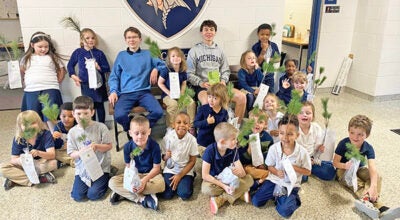Future of Fort St. Joseph discussed at Niles conference
Published 8:40 am Wednesday, October 1, 2014

Participants packed the library’s rotunda during a keynote address at the conference. (Submitted photo)
What should be done with the Fort St. Joseph archaeological site in Niles?
That was the question posed to archaeologists, educators, scholars, city officials and others during the 10th annual Midwest Historical Archaeological Association Conference held Friday and Saturday at the Niles District Library.
Around 100 people were in attendance over the weekend, according to Dr. Michael Nassaney, a Western Michigan University professor and lead investigator for the Fort St. Joseph Project at WMU.
“We were able to exchange ideas and are now beginning to see a whole range of possibilities for the site,” Nassaney said.
Fort St. Joseph refers to the garrison and trading post complex occupied from 1691 to 1781 by the French and British. It is located on the banks of the St. Joseph River on property owned by the City of Niles.
Nassaney has been leading an effort by WMU faculty and students to identify, investigate and interpret the remains of the Fort over the past 15 years.
Open houses have been held at the dig site almost every year since 2004 in order to educate the public about the former Colonial outpost.
Juan Ganum, Niles Community Development Director, attended the workshop. He said Fort St. Joseph could one day become important to the city as a heritage tourism destination.
“There are certainly historical benefits from unearthing these artifacts and exhibiting them and interpreting them,” he said, “but what we as a community and a local unit of government have essentially acknowledged is that there is a tremendous economic benefit potential.”
Nassaney said his students are working on compiling the information gained at the workshop in order to develop a planning document for the future of the site. The planning document will then be presented to and assessed by the Fort St. Joseph Archaeological Advisory Committee, which includes city officials, WMU staff and other interested community members.
“We hope to have it done by the end of the semester,” Nassaney said. “Then they (the advisory committee) will decide what they want to adopt from it, what to share with the (Niles) City Council and what makes most sense to them.”
Nassaney said two of the main challenges in moving the project forward include getting all the groups that have a vested interest in the Fort on the same page and determining how to best interpret a site that is flooded for a good part of the year.
“We hope this conference helped find solutions to these issues,” he said.
Nassaney said Niles will play an important role in the Fort’s future as the site is located on city property, meaning Niles is responsible for preserving and storing artifacts collected from the site.
Ganum said he left the conference with a better idea of what the Fort’s future might look like.
“I think it was a worthwhile exercise and I am personally looking forward to all of the comments and recommendations that are going to be compiled by the students and the facilitator,” Ganum said.






